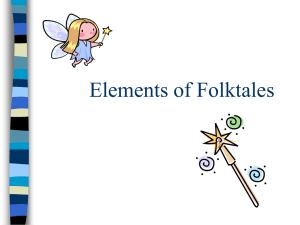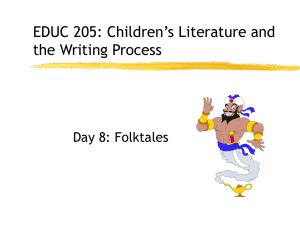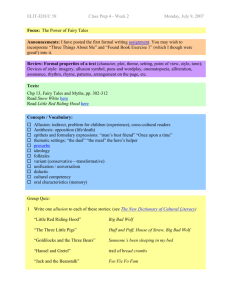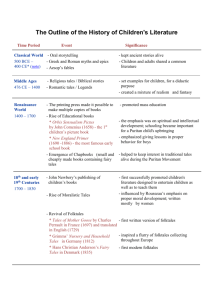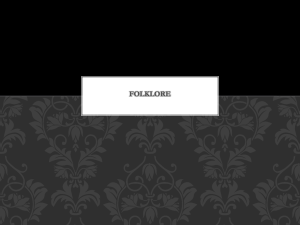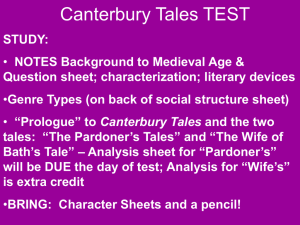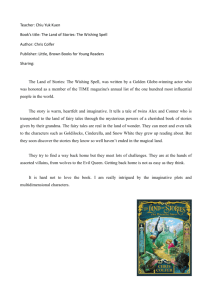File
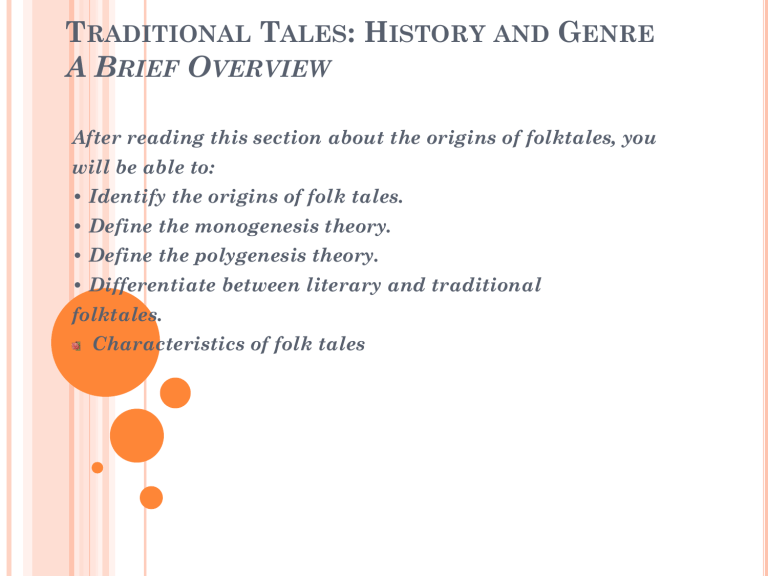
T RADITIONAL T ALES : H ISTORY AND G ENRE
A B RIEF O VERVIEW
After reading this section about the origins of folktales, you will be able to:
• Identify the origins of folk tales.
• Define the monogenesis theory.
• Define the polygenesis theory.
• Differentiate between literary and traditional folktales.
Characteristics of folk tales
T HE H ISTORY OF F OLKTALES
Folktales in various forms have been around for centuries. Whether they are tall tales of heroes or folktales
The origin of folktales is subject for debate. This is because folktales are generally derived from stories that have been told from person to person, and likely may have changed in the re-telling.
The Merriam Webster Dictionary defines a folktale as “a characteristically anonymous, timeless, and place less tale circulated orally among a people”. It could be:
1. fictional characters
2. non-fictional characters.
While folktales are worldwide, and date back to biblical times, some of the most common folktales that we are familiar with are based in the United States dating back to the American
Revolution. This includes
The Ghosts of Ringwood Manor,
The Army of the Dead Confederate Soldiers, the Connecticut Yankee,
Daniel Boone, - frontier man (scout)
John Henry, - Railroad worker
Casey Jones, - Railroad driver
Johnny Appleseed – a traveler who plant apple tree wherever he went
Pecos Bill – cowboy….roped a typhoon,tornado, etc
Folktales are a broad category of oral stories that have been passed along by generations and captured in print.
Within the folktale category are other types of stories such as myths, fables, fairy tales, tall tales and legends. Each category has a variety of stories that have been part of our history.
Folktales and similar stories have been around for centuries and continue to this day.
HOW WAS IT Developed?
Folktales developed from the necessity of people to try to explain and understand the natural and spiritual phenomenon that occurred in their daily lives.
It is impossible to pin point the exact date of the beginning of this literary genre. What can be stated is that it goes back to the oral traditions of people.
It was around the 12th century that the first literary sources began to circulate in European land. And from here on, the oral tradition evolved into writing.
Literary tales are those written tales by known author from oral traditions
An example is Hans Christian Anderson who wrote 168 tales. One of his best known stories is The Emperor’s
New Suit (1837).
It is interesting to note that similar patterns in the traditional tales around the world seem to prevail.
Scholars have come up with several hypotheses to explain this phenomenon. One of these hypotheses is that probably the traditional tales were passed to different lands by the migration of the people. As these people moved from place to place, they took their stories with them.
Most of these people were probably sailors, soldiers, women stolen from tribes, slaves, captives from wars, traders, minstrels as well as bards.
Those scholars who believe that traditional tales derived from an original source support the monogenesis theory.
This idea was supported by the Grimm Brothers. They believed that every folk tale could be traced to the prehistoric group Aryans, known now as the Indo-
Europeans.
C HARACTERISTICS
Folktales were the oral tradition of adults.
Stories about peoples' lives and imaginations and as they struggled with their fears and anxieties in these tales around the campfire, they became better able to struggle with them in reality.
While many of these tales weren't told specifically for children it is almost certain that they too would listen and enjoy as well as develop respect for certain elements described in the stories
T HEMES
Usually universal truths, lessons, and values related to people, their actions, and/or material goods that is valued by the group that creates the folktale. These tales tell what happens to those who do not obey the groups traditions.
Problems of young adults
Security
Fear of leaving home
Fear of not having children
Fear of not being loved or giving love
Reflect basic values and concerns of different cultures
Good and evil
Right and wrong
Justice and injustice
Happiness, kindness, friendship, loyalty
Good triumphant over evil
Love and loyalty
Love and loyalty can transform ...
Discuss basic values of people
Characterization
Characters are flat. Either very good or very bad with most characteristics exaggerated. The hero and heroine are usually young. The heroine is usually fair, kind, charitable, and caring. The hero is usually honorable, courageous, unselfish, and caring. Both usually have special powers.
Setting
Place is described easily and briefly (humble cottage, magic kingdom) that fits the typical geography of the culture or it is not mentioned but assumed. Time is in the past (usually longago) imbedded within the history of the culture.
Time is fantasy time (Once upon a time sets the stage and
They lived happily ever after closes the tale.) any time or any place, timeless or placeless, or long long ago.
Plot
Is full of action and follows specific and simple patterns. The plot starts right out with fast moving action that grabs the listeners interest and keeps it. Conflicts are usually resolved with great deeds or acts of human kindness related to good and bad/evil.
STYLES
Descriptions are quick and to the point with little description and detail.
Plausability story is possible but not probable.
A promise father promises to send one daughter, if set free; promises first son, if spin gold;
Number three father has three daughters and three sons, and three weeks to return
Magic
Supernatural beings
Objects (mirror, beans, golden objects)
Spells, Enchantments, Magical transformations, Character transformed by a spell and only the love or loyalty of another character can break the spell, ugly person casts a spell on … Spell is broken and turns into a ...
Run away from home Gingerbread Boy - English, The Bun -
Russian, The Pancake – Norwegian
Extraordinary animals, monster, or other animated
thingsThree Little Pigs, Shrek
Explain a natural phenomena or custom. How Rabbit Stole Fire,
Why Mosquitoes Buzz in people's Ears, Tikki Tikki Temkbo.
Good versus bad/evil
R EMEMBER …
• Folktales derive from the oral tradition.
• Around the 12th century the oral tradition evolved into writing (Europe).
• Some people believe that traditional tales were passed along different lands through migration
(i.e. sailors, traders, bards, slaves).
• Literary tales are the ones whose authors are known.
• The monogenesis theory mentions that traditional tales have their origins with the Indo-Europeans known in
Grimm’s time as Aryans.
• The polygenesis theory believes traditional tales derive from different sources. What they have in common is presenting humanity’s desires and needs which are to them universal. This is according to the supporters of this
End…….
THANK YOU
Reported by:
Alma Gomes
![Essay #4: [4 Short essays will substitute Essay 4]](http://s3.studylib.net/store/data/007737676_2-779981057889e025637152af438b827f-300x300.png)

